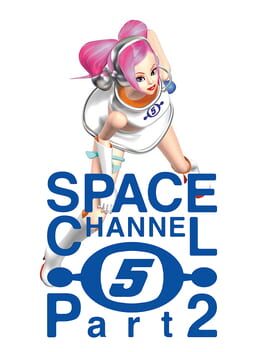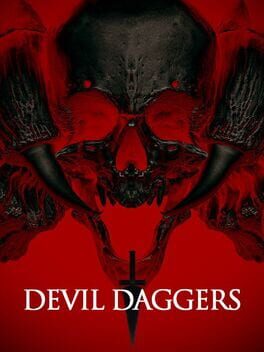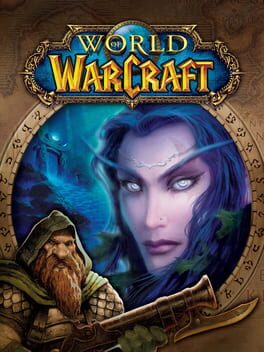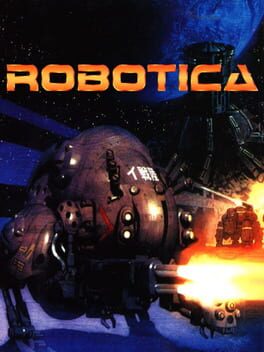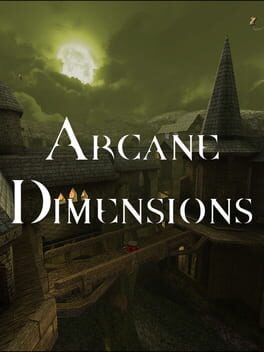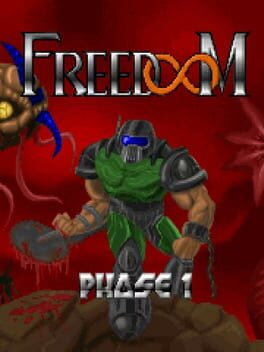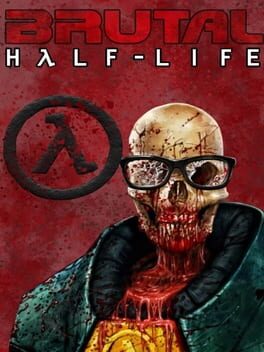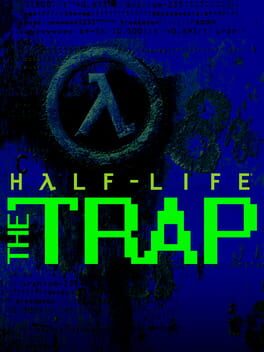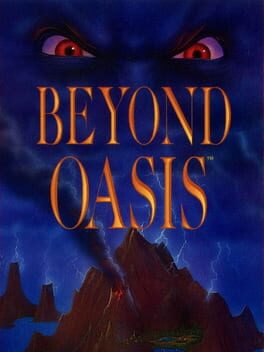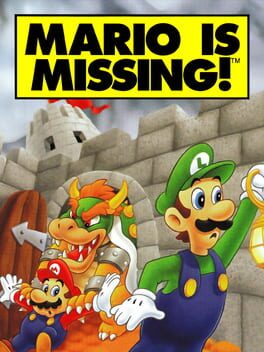johnromero
91 reviews liked by johnromero
no other game experiments with diegetic rhythm gameplay like space channel 5 part 2. eschewing the opaque freestyle gameplay of the similar parappa series, space channel 5 instead presents easy-to-grasp rhythms conveyed via creative visual cues. the call-and-response challenge paradigm is accented with twists that extend beyond pure memorization: long strings of inputs may be symbolized by the movements of a boss robot's appendage, or panels featuring dance poses lighting up in time with the backing beat. once basic concepts are established, the designers throw curveballs to screw with the player and add some much-needed challenge to the experience. you may have to single out an out-of-place opponent who sings the wrong input, or carefully count spores crashing down from a gargantuan mutated plant. as each stage goes on the music gets progressively faster and the commands begin demanding better reflexes all the way up until a climatic motif that ends each stage. even with its simplicity it's an absolute ball to play.
the game also oozes a retro sci-fi style that showcases go-go boots, smooth curved architecture, and rave-tinged big band tunes. I absolutely need to shout out director yumiko miyabe, who created the original design for protagonist ulala in the first game as well as having art/CG credits on other sega staples like panzer dragoon saga and NiGHTS. it's obvious that she was a primary influence on the game's unique vibrance and campy encounters. this game also boasts fully 3D environments that vastly outdo the crunchy FMV backdrops of the first game. there's a much heavier focus on environment interaction in this one given that elements can change on the fly much more quickly, and towards the end it segues into some truly abstract areas filled with gripping tessellations. these combined with the extensive choreography and the eclectic musical themes work fuse in a way that absolutely screams "Dreamcast."
the game is not long, but at the very least they added some neat extra content on to satiate those aching squeeze more out of the campaign. there's a pseudo hard-mode that's unlocked after finishing the main story; I wouldn't call it a true hard mode since not all sections have more challenging patterns, but at least they tried to stretch it as far as they could. there's also a special survival mode with a hand-selected set of rhythms that will truly test a player's mettle given that a single mistake will send you right back to the start. setting high scores on the main stages and getting far in survival mode will unlock extra costumes, which functionally serve as a proto-achievement system. to add an extra layer of complexity, there are also multiple hidden inputs in each stage that can be subtly noticed by additional accents present in the backing tracks even when left unsaid in actual gameplay. that commitment to unorthodox ways to extend the replayability of these short titles is exactly what I expect from a sega title, and part 2 absolutely leapfrogs the first in that respect.
it helps that this is the only one available on modern platforms, as the aforementioned FMV backdrops of the original have seemed to let it fade into obscurity. this is the superior game by any metric anyway, so stream it live with your friends. revel in the charmingly awkward localized singing and cheerful grooves present throughout. indulge in one of the best early console rhythm titles available!!
the game also oozes a retro sci-fi style that showcases go-go boots, smooth curved architecture, and rave-tinged big band tunes. I absolutely need to shout out director yumiko miyabe, who created the original design for protagonist ulala in the first game as well as having art/CG credits on other sega staples like panzer dragoon saga and NiGHTS. it's obvious that she was a primary influence on the game's unique vibrance and campy encounters. this game also boasts fully 3D environments that vastly outdo the crunchy FMV backdrops of the first game. there's a much heavier focus on environment interaction in this one given that elements can change on the fly much more quickly, and towards the end it segues into some truly abstract areas filled with gripping tessellations. these combined with the extensive choreography and the eclectic musical themes work fuse in a way that absolutely screams "Dreamcast."
the game is not long, but at the very least they added some neat extra content on to satiate those aching squeeze more out of the campaign. there's a pseudo hard-mode that's unlocked after finishing the main story; I wouldn't call it a true hard mode since not all sections have more challenging patterns, but at least they tried to stretch it as far as they could. there's also a special survival mode with a hand-selected set of rhythms that will truly test a player's mettle given that a single mistake will send you right back to the start. setting high scores on the main stages and getting far in survival mode will unlock extra costumes, which functionally serve as a proto-achievement system. to add an extra layer of complexity, there are also multiple hidden inputs in each stage that can be subtly noticed by additional accents present in the backing tracks even when left unsaid in actual gameplay. that commitment to unorthodox ways to extend the replayability of these short titles is exactly what I expect from a sega title, and part 2 absolutely leapfrogs the first in that respect.
it helps that this is the only one available on modern platforms, as the aforementioned FMV backdrops of the original have seemed to let it fade into obscurity. this is the superior game by any metric anyway, so stream it live with your friends. revel in the charmingly awkward localized singing and cheerful grooves present throughout. indulge in one of the best early console rhythm titles available!!
Devil Daggers
2016
"Simplicity is the ultimate sophistication", in which Devil Daggers excels. What seems like a game that could have been made in a week, yet captured an audience far beyond what the developer probably expected. This is one of those games made by conceptual geniuses, who don't excel in the technicality but rather in untamed territories; Breakout, Robotron 2084, or Dance Dance Revolution. Simple concepts which aim to revolutionize and inspire, are simplistic. True "idea guys", likes of Eugene Jarvis.
Devil Daggers gameplay can last anywhere from a minute to hours, it's a simple plug-and-play, fast shooter putting you in a hellish arena of Lovecraftian proportions, or rather disproportion. There is little design beyond what is presented in front of you. Controls are rather simple and can be understood within a matter of seconds; yet - take forever to master, as the game pits you immediately against impossible odds. Devil Daggers is instant gratification and action no matter your skill level. There is no beating the game, just lasting over a minute is enough for a satisfying session, with a simple goal: survive.
Devil Daggers gameplay can last anywhere from a minute to hours, it's a simple plug-and-play, fast shooter putting you in a hellish arena of Lovecraftian proportions, or rather disproportion. There is little design beyond what is presented in front of you. Controls are rather simple and can be understood within a matter of seconds; yet - take forever to master, as the game pits you immediately against impossible odds. Devil Daggers is instant gratification and action no matter your skill level. There is no beating the game, just lasting over a minute is enough for a satisfying session, with a simple goal: survive.
World of Warcraft
2004
No 1 will believe me ... But it is true. On the illidan server whence i learned the sickest, And illegal ideas, I was the Horde Side Ganker known as " the thandol span 'assaulter' ". That last word is a replacement i cant say the original anymore, it Starts with an r. Not a good word.Not good deeds. But i cannot run from my past.
Robotica
1995
Robotica, known in Japan as "Daedalus" feels like FromSoft's Armored Core started as a King's Field game.
It features more than satisfying graphics and a trendy ambient soundtrack, in fact, Robotica's presentation goes beyond most shooters I've seen from the early 90s until Quake of course. There's no saving system, and its levels are randomly generated so you're always getting a new experience. The FMV is really decent for an early 90s title and eliminates loading times between areas. It all sounds really good on paper, so what is the problem?
Robotica is a slow game - it's painfully slow, we get that you're controlling this tank mech, the game is trying to imitate Mechwarrior or tank games perhaps too closely. As we said, its levels are randomly generated, so you're bound to experience the same Wolf-like level design over and over, there's not a lot of souls put into it, it's definitely like advertised, Robotica...l? You'll be wandering these square rooms with a random assortment of enemies in each of them. While the graphics are really good, there's this draw distance that blocks your view of anything not at point-blank, at least there's a radar on your HUD. The game gets darker as you go deeper through the game, maybe to compensate for more enemies being on screen because the game was already running at around 15 FPS on the first level.
It's not that awful a game, if you want something flashy for your Saturn maybe give it a try, it's definitely a good-looking game to play on a CRT screen... but the game itself, meh. I won't "spoil" it for you, but the "end boss" is as fascinating as you'd expect.
I gave it 1 ½ for its great soundtrack and presentation, it's just not that diverting of a game.
It features more than satisfying graphics and a trendy ambient soundtrack, in fact, Robotica's presentation goes beyond most shooters I've seen from the early 90s until Quake of course. There's no saving system, and its levels are randomly generated so you're always getting a new experience. The FMV is really decent for an early 90s title and eliminates loading times between areas. It all sounds really good on paper, so what is the problem?
Robotica is a slow game - it's painfully slow, we get that you're controlling this tank mech, the game is trying to imitate Mechwarrior or tank games perhaps too closely. As we said, its levels are randomly generated, so you're bound to experience the same Wolf-like level design over and over, there's not a lot of souls put into it, it's definitely like advertised, Robotica...l? You'll be wandering these square rooms with a random assortment of enemies in each of them. While the graphics are really good, there's this draw distance that blocks your view of anything not at point-blank, at least there's a radar on your HUD. The game gets darker as you go deeper through the game, maybe to compensate for more enemies being on screen because the game was already running at around 15 FPS on the first level.
It's not that awful a game, if you want something flashy for your Saturn maybe give it a try, it's definitely a good-looking game to play on a CRT screen... but the game itself, meh. I won't "spoil" it for you, but the "end boss" is as fascinating as you'd expect.
I gave it 1 ½ for its great soundtrack and presentation, it's just not that diverting of a game.
Arcane Dimensions
2018
If Arcane Dimensions had anything to say about it, it would knock the original Quake out of five stars. Arcane Dimensions is one of the best, most polished partial conversions that we've seen on the Quake engine.
Arcane Dimensions include a large number of new enemies throwing off the usual Quake player, this is about the same quality that you'd expect in one of the officialized mission packs, only a notch higher. Ogre, grunts, and knight come back from the original Quake base game, only in much more varied forms.
Maps are some of the best works of craftsmanship I've seen on the Quake engine so far, Arcane Adamantine and Tears of the False God was probably my favorite experience with any DOOM/Quake game so far. Enemies constantly surround the players and you never feel quite safe from bobby traps, just as a competent map should feel. Its maps are varied, yet do not break themes. Made with the newest "TrenchBroom" level editor, it pioneered the next generation of Quake level editing and kickstarted a 'Quake Renaissance.
There are a few crashes here and there, we haven't encountered that much personally, and the final game is so much unadulterated fun that the few crashes just mean you'll get to replay some of your favorite maps. We would like to see this map pack ported to Quake Remastered eventually, as we still had to run legacy Quake to play on it.
Just play Arcane Dimensions, after the base game and having finished each mission pack, up to Dimension of the Machine...
Our only regret is that Arcane Dimensions is about as good as Quake really gets, or is it...
Arcane Dimensions include a large number of new enemies throwing off the usual Quake player, this is about the same quality that you'd expect in one of the officialized mission packs, only a notch higher. Ogre, grunts, and knight come back from the original Quake base game, only in much more varied forms.
Maps are some of the best works of craftsmanship I've seen on the Quake engine so far, Arcane Adamantine and Tears of the False God was probably my favorite experience with any DOOM/Quake game so far. Enemies constantly surround the players and you never feel quite safe from bobby traps, just as a competent map should feel. Its maps are varied, yet do not break themes. Made with the newest "TrenchBroom" level editor, it pioneered the next generation of Quake level editing and kickstarted a 'Quake Renaissance.
There are a few crashes here and there, we haven't encountered that much personally, and the final game is so much unadulterated fun that the few crashes just mean you'll get to replay some of your favorite maps. We would like to see this map pack ported to Quake Remastered eventually, as we still had to run legacy Quake to play on it.
Just play Arcane Dimensions, after the base game and having finished each mission pack, up to Dimension of the Machine...
Our only regret is that Arcane Dimensions is about as good as Quake really gets, or is it...
Freedoom
2003
Doom... for Free? What's the catch?
Freedoom was a project aiming to create a completely free IWAD file that would be distributed free of charge following the release of the Doom engine under a non-commercial free use license in 1997. Hearing the news, Simon Howard took it upon himself to release DOOM to everyone, which meant creating a total conversion for every asset of the game, save for the engine.
While the maps of Freedoom weren't particularly as good as the original game, owning both the engine and the base game meant you could essentially download any wad or megawad, the only difference being the demons would be replaced with aliens, each behaving like their demonic counterparts. Textures and soundtrack would also be slightly different, as they were also licensed.
We actually loved playing Freedoom, while the sprites aren't quite as detailed and we have no nostalgia whatsoever for it, it does feel like playing an entirely different game, something akin to Chex Quest. In that sense, some of the monsters are definitely goofier than their Doom counterpart, but I actually much prefer the flesh worm over the pinkie, and the imps and soldiers are really rads as well. We feel the iwad would really compliment a sci-fi map. Soundtrack sounds surprisingly tight sometimes, E1M4 is probably my favorite track, but E2M3 is equally as awesome.
There were few projects as extensive as Freedoom back then, most wads from the 90s are actually quite simplistic, and the task of replacing every map and asset of the base DOOM game was a hard task to undertake... and all for a wholesome cause.
Freedoom is pretty sick, even if you own the base game you should check it out, even if solely for the historical value of it.
Freedoom was a project aiming to create a completely free IWAD file that would be distributed free of charge following the release of the Doom engine under a non-commercial free use license in 1997. Hearing the news, Simon Howard took it upon himself to release DOOM to everyone, which meant creating a total conversion for every asset of the game, save for the engine.
While the maps of Freedoom weren't particularly as good as the original game, owning both the engine and the base game meant you could essentially download any wad or megawad, the only difference being the demons would be replaced with aliens, each behaving like their demonic counterparts. Textures and soundtrack would also be slightly different, as they were also licensed.
We actually loved playing Freedoom, while the sprites aren't quite as detailed and we have no nostalgia whatsoever for it, it does feel like playing an entirely different game, something akin to Chex Quest. In that sense, some of the monsters are definitely goofier than their Doom counterpart, but I actually much prefer the flesh worm over the pinkie, and the imps and soldiers are really rads as well. We feel the iwad would really compliment a sci-fi map. Soundtrack sounds surprisingly tight sometimes, E1M4 is probably my favorite track, but E2M3 is equally as awesome.
There were few projects as extensive as Freedoom back then, most wads from the 90s are actually quite simplistic, and the task of replacing every map and asset of the base DOOM game was a hard task to undertake... and all for a wholesome cause.
Freedoom is pretty sick, even if you own the base game you should check it out, even if solely for the historical value of it.
Brutal Half-Life
2018
Brutal Half-Life can be way easier than the base game, nonetheless, it completes Half-Life's over-the-top slapstick experience and the modification is an absolute fever dream of gore, excessive weaponry, and turns Half-Life into an 80s Stallone action flick. It's not as mauvais goût as Brutal DOOM however, many of the core aspects of the game remains the same and aren't made crowded by the new mechanics in place.
There is a new level selection inspired by Quake and new maps including The Splitgate Complex and Outerbase from their respective Quake game (E1M1 and Base1), as well as the DOOM E1M1 maps from the first two titular games.
The modification has been on hiatus since the release of Beta 2 and the third Beta seems nowhere to be found, with total radio silence from the development team. Still, what has been presented so far is more than competent and fully playable and did make Half-Life more enjoyable to replay. Our only complaint is how the mod adds iron sights, but those are still only optional and welcome "additions".
There is a new level selection inspired by Quake and new maps including The Splitgate Complex and Outerbase from their respective Quake game (E1M1 and Base1), as well as the DOOM E1M1 maps from the first two titular games.
The modification has been on hiatus since the release of Beta 2 and the third Beta seems nowhere to be found, with total radio silence from the development team. Still, what has been presented so far is more than competent and fully playable and did make Half-Life more enjoyable to replay. Our only complaint is how the mod adds iron sights, but those are still only optional and welcome "additions".
Half-Life: The Trap
2008
"The Trap" follows the plot of most escape room titles: Cube (1997) or Portal (2007). You've probably heard of the trope by now: you are captured and put in a mouse maze by treacherous, sadistic captors, this time, it's a classic alien abduction story.
Navigate "The Trap": a viscera of obtuse machinery using the full extent of the GoldSrc engine. While certainly nightmarish for our poor protagonist; this is a dream come true for every fan of the original Half-Life, and an orgy to enthusiasts of its then-incredible physics engine. While - granted - the original Half-Life had avant-garde platforming sections using the most of its physics engine, sadly its puzzles were often nothing more but box puzzles. "The Trap" goes far beyond that, with multiple-room puzzles, far more intricate, convoluted, and even deceitful at times.
As you enter each trap room, your alien overlords may take or give weapons - rather tools - as they see fit, diminishing or strengthening your odds. In their world, primal "weapons" such as pistols, grenades, to your trusty crowbar are merely toys for their selfish amusement.
While the story is undeniably cliché by now, the execution remains terrific - in every sense of the word. Its atmosphere captures the isolation and discombobulating horror of escape room movies as flawlessly as its idols; yet, there is also a fair bit of tongue-in-cheek humor very reminiscent of Portal, keeping things fresh, delicately facetious.
Better or not than its contemporaries, "The Trap" was certainly a one-man party.
Navigate "The Trap": a viscera of obtuse machinery using the full extent of the GoldSrc engine. While certainly nightmarish for our poor protagonist; this is a dream come true for every fan of the original Half-Life, and an orgy to enthusiasts of its then-incredible physics engine. While - granted - the original Half-Life had avant-garde platforming sections using the most of its physics engine, sadly its puzzles were often nothing more but box puzzles. "The Trap" goes far beyond that, with multiple-room puzzles, far more intricate, convoluted, and even deceitful at times.
As you enter each trap room, your alien overlords may take or give weapons - rather tools - as they see fit, diminishing or strengthening your odds. In their world, primal "weapons" such as pistols, grenades, to your trusty crowbar are merely toys for their selfish amusement.
While the story is undeniably cliché by now, the execution remains terrific - in every sense of the word. Its atmosphere captures the isolation and discombobulating horror of escape room movies as flawlessly as its idols; yet, there is also a fair bit of tongue-in-cheek humor very reminiscent of Portal, keeping things fresh, delicately facetious.
Better or not than its contemporaries, "The Trap" was certainly a one-man party.
Beyond Oasis
1994
"Beyond Oasis: The Story of Thor" is Ancient and SEGA's answer to "Legend of Zelda: A Link to the Past", from the same developers who brought us the excellent "Streets of Rage 2" and "Streets of Rage 3". You can see some of the beat 'em up influence in its gameplay, but beyond the surface, it remains another Zelda clone. Weirdly enough, the game has no mention of Thor anywhere in the game, except it's title, ironically, the main character is named "Prince Ali" and has an appearance reminiscent of the Prince of Persia protagonist. The game's story resolves around two amulets, the gold amulet and the silver amulet, Prince Ali finds the gold amulet and is sent on a quest to stop the bearer of the silver amulet, bent on destruction. What follows is a Zelda clone with great graphics, the sprites and environments are rich in detail and smoothly animated. Most of the game is spent navigating through dungeons, defeating each bosses and collecting special items, throughout the game, the player frees four genies, gaining unique summoning abilites.
Mario Is Missing!
1993
Take him to Detroit.
